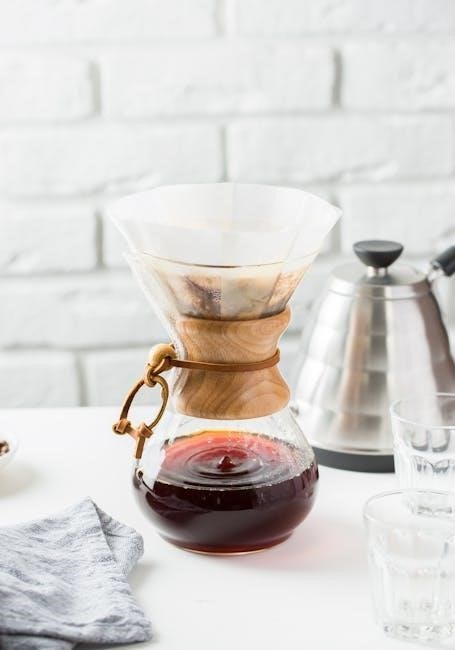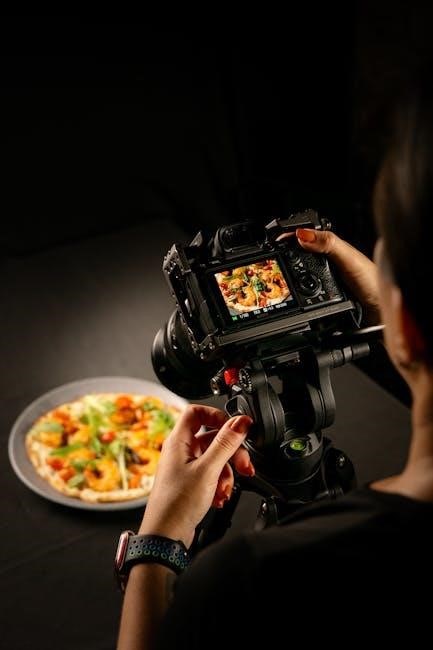Writing a recipe requires clarity and precision to guide cooks effectively. It involves listing ingredients‚ specifying measurements‚ and detailing steps in logical order. A well-crafted recipe ensures dishes are recreated consistently and deliciously every time.
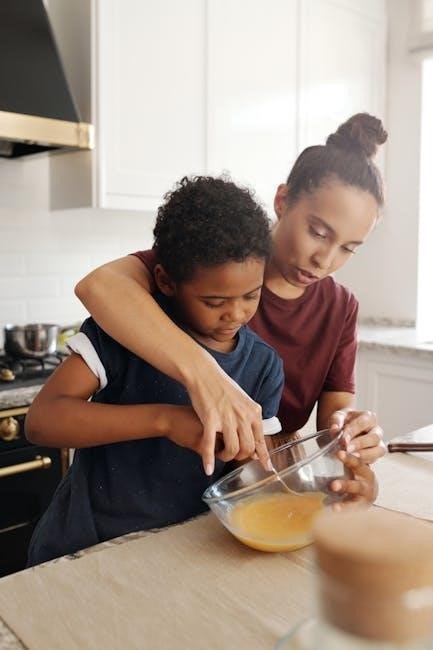
Structure of a Recipe
A recipe typically includes a title‚ description‚ servings‚ preparation time‚ ingredients list‚ and step-by-step instructions. Each section is designed to guide cooks through preparing a dish efficiently and effectively.

Title and Description
The title of a recipe should be clear and engaging‚ reflecting the dish’s name and key ingredients. It should grab attention while accurately representing the meal. A good title might include the recipe’s origin or a unique feature‚ such as “Classic Italian Lasagna” or “Spicy Vegan Chili.”
The description provides context and appeal‚ explaining the dish’s flavor profile‚ texture‚ or significance. It can include serving suggestions or personal anecdotes‚ like “A hearty‚ comforting casserole perfect for family dinners” or “Inspired by my grandmother’s traditional recipe.” This section sets expectations and entices readers to try the dish. Keep the description concise yet vivid to engage the audience effectively.

Servings and Preparation Time
Servings indicate how many people the recipe can feed‚ ensuring cooks prepare the right quantity. It helps in scaling the recipe up or down based on the number of diners. Preparation time provides an estimate of how long it takes to complete the dish‚ including both active cooking and passive steps like marinating or baking. This information helps cooks plan their schedule effectively‚ avoiding last-minute rushes and ensuring timely serving. Accurate servings and preparation times enhance the cooking experience by setting clear expectations. They are essential for meal planning and time management‚ making the recipe user-friendly and practical for home cooks and professionals alike. Including these details demonstrates consideration for the cook’s needs‚ fostering trust and satisfaction in the recipe’s guidance. This clarity is key to a successful and enjoyable cooking process.
Ingredients List
The ingredients list is a crucial part of any recipe‚ detailing all the components needed to prepare the dish. It should be comprehensive‚ including every item‚ from the main elements to spices and seasonings. Each ingredient should be listed in the order it appears in the instructions‚ ensuring a smooth cooking process. Measurements are essential‚ providing precise quantities to guarantee the dish turns out as intended. Common abbreviations‚ like “tbsp” for tablespoons‚ are often used for clarity. Listing ingredients in chronological order helps cooks gather and prepare everything efficiently. Separating ingredients for major steps‚ such as distinguishing between those for the crust and filling in a pie‚ adds organization. This structure prevents errors and ensures no component is overlooked. A well-organized ingredients list enhances the cooking experience‚ making it easier for cooks of all skill levels to follow the recipe successfully.

Writing the Ingredients List
Ingredients should be listed in chronological order‚ separated by major steps if needed. Use precise measurements and clarity‚ ensuring each item is easily identifiable. This organization aids cooks in preparation and accuracy.
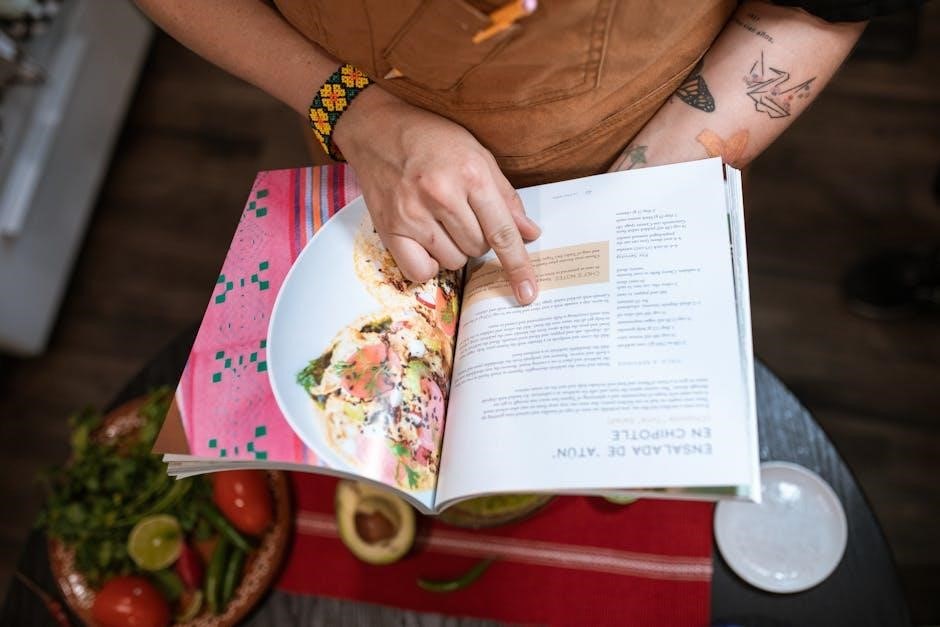
Order and Separation
Organizing ingredients chronologically ensures cooks can follow the recipe seamlessly. Separate ingredients for major steps‚ like separating dough and filling components. This structure prevents confusion and streamlines the cooking process. Each item should be listed in the order it appears in the instructions‚ making it easier to track progress. For example‚ if a recipe requires flour for dusting and then for the dough‚ list them accordingly. This logical flow helps avoid kitchen errors and ensures all elements are prepared at the right time. Proper separation also highlights key components‚ making the recipe intuitive. Using clear headings or bullet points enhances readability‚ while specific measurements and descriptions guarantee accuracy. This methodical approach transforms a simple list into a dynamic guide‚ elevating the cooking experience.
Crafting Clear Instructions
Use imperative verbs and concise language for step-by-step clarity. Ensure each instruction logically follows the previous one‚ avoiding ambiguity. Keep sentences short and free of unnecessary details to prevent confusion during cooking.

Clarity and Use of Images
Clarity is essential for ensuring recipes are easy to follow. Use simple‚ direct language and avoid overly complex sentences. Images can enhance understanding by visually guiding cooks through intricate steps‚ such as folding batter or decorating cakes. Place images near relevant instructions to prevent confusion. Captions or annotations can further clarify techniques or ingredient preparation. While images are helpful‚ they should complement‚ not replace‚ clear written instructions. Overloading with visuals can distract‚ so use them sparingly and strategically. Ensure high-quality images that accurately represent each step or ingredient. This balance of clear writing and supportive visuals creates a user-friendly recipe that cooks of all skill levels can follow confidently.
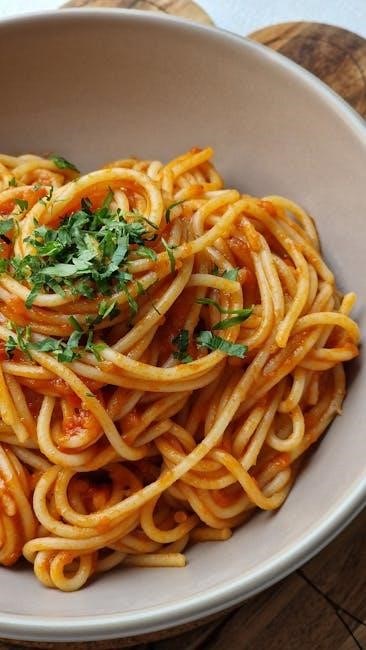
Safety Tips

When writing a recipe‚ it’s crucial to include safety tips to ensure a hazard-free cooking experience. Always mention handling hot appliances with oven mitts or tongs. Emphasize the importance of sharp knives being stored safely and used with care. Highlight proper food handling to prevent cross-contamination‚ especially with raw ingredients like meat or eggs. Note the need for proper ventilation when cooking with oil or strong-smelling foods. Warn against leaving cooking unattended‚ particularly when frying or grilling. Advise readers to keep children away from hot surfaces and sharp objects. Include tips on proper knife techniques‚ such as cutting away from the body. Remind cooks to check for allergies or dietary restrictions before serving. Finally‚ suggest testing recipes to ensure accuracy and safety. By prioritizing safety‚ your recipe becomes a reliable and enjoyable guide for all cooks.
Enhancements and Variations
Enhancing and varying a recipe allows for creativity and personalization. Consider suggesting optional ingredients or substitutions‚ such as herbs‚ spices‚ or alternative cooking methods. For example‚ adding a garnish like fresh parsley or a squeeze of lemon can elevate the dish. Offer variations for dietary preferences‚ like vegan or gluten-free options‚ by substituting specific ingredients. Providing serving suggestions‚ such as pairing with a side salad or rice‚ can also enhance the overall dining experience. Additionally‚ include tips for making the recipe more elaborate‚ such as adding a sauce or marinade. Encourage experimentation with flavors‚ like adding a pinch of cumin for a smoky taste or a dash of chili for heat. Finally‚ mention ways to present the dish attractively‚ such as arranging ingredients artfully or using colorful garnishes. These enhancements and variations make the recipe adaptable and inspiring for cooks of all levels.
Crafting a well-written recipe is essential for ensuring dishes are prepared successfully. Clarity‚ precision‚ and organization are key‚ guiding cooks through each step seamlessly. Testing recipes and understanding the audience are crucial for reliability. By following structured guidelines‚ recipes become accessible and enjoyable for everyone. This approach fosters confidence in cooking‚ making the culinary experience rewarding and delightful for all involved.

